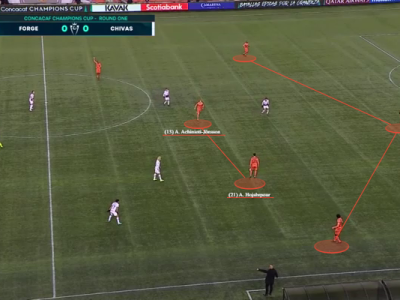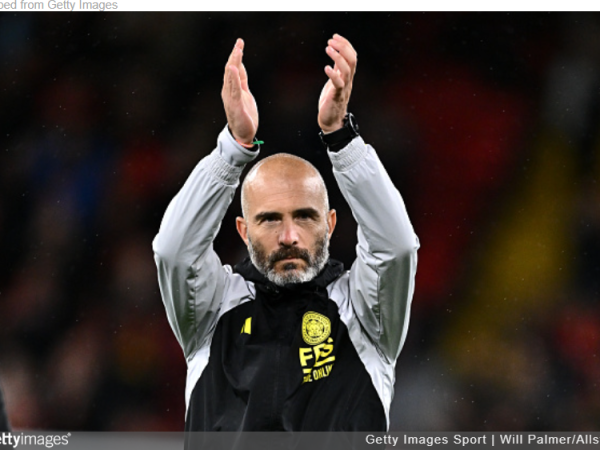Ahead of Leipzig’s weekend clash with FC Koln, Die Roten Bullen entered Matchday 5 on just 3 points, beating (and battering) only Stuttgart in their opening four fixtures. It’s safe to say that’s far from the start Jesse Marsch would have been hoping for in his first five matches at Red Bull Arena. 13th place is not necessarily a reflection of how they’ve played so far this season, but it is also certainly not where anyone would have thought they’d be at this stage. So what has gone wrong for Jesse Marsch’s team so far? We take a look at some of the key issues in our latest tactical analysis.
changes to shape and personnel
Embed from Getty ImagesOne of the hallmarks of RB Leipzig under Julian Nagelsmann was tactical innovation, as the team utilized a variety of complex back-three shapes. Leipzig were generally at their best under the German manager when utilizing wingbacks in some sort of 3-1-4-2 or 3-4-2-1. Since coming in, Jesse Marsch has stuck to a pragmatic and simplistic 4-2-3-1 shape, that is not utilizing much in the way of the wing-back width seen under Nagelsmann. Marsch’s defenders have been more reserved, and more likely to create from deep via longer passes over the top, rather than exciting wing play. Angelino’s been frozen out completely in place of the defensively Gvardiol, and in the process Die Roten Bullen have lost a key attacking weapon. At 19, Gvardiol is highly promising and already an immaculate 1v1 defender, but it’s clear for all to see that he lacks the same sort of ‘get the ball into the box’ ability that Angelino provides. Hee-Chan Hwang was also let go to Wolves, despite the success he had under Marsch for RB Salzburg in the past. So some strange decisions have been made, on top of the already disappointing departures of Dayot Upamecano and Marcel Sabitzer to Bayern Munich. It’s not to be underestimated how much the loss of Upamecano and Sabitzer matters, but Leipzig’s problems go far beyond that.
In large part, the 4-2-3-1 is playing a massive role in Leipzig’s lack of quality this season. It’s compelled them to be far too narrow, and forced Andre Silva up front on his own, where he’s often isolated and easily tracked. Leipzig were fairly narrow under Nagelsmann, but they still had width in the form of their wing-backs, and structures in place for attacking midfielders and wing-backs to combine and create overloads in wide areas. Marsch’s team have none of that, as they instead pass the ball around at the back with an identity crisis as to how to progress beyond that.
narrow attack
Embed from Getty ImagesSo let’s get to one of the bigger, gaping holes in the side. Leipzig have attacked this season using a very narrow approach, with each of their attacking quartet in close quarters – roaming in central areas. Only Stuttgart have attacked through the middle more, as part of their quick transition, high tempo mentality. The problem that presents Leipzig is that their attack then becomes overly-reliant on playing through the thirds, and one-touch passing sequences that only work when their opposition is already unbalanced. This worked to such a great extent against Stuttgart, who are always running around so much in attack that they forget and neglect to properly set up their defensive structures. Against the other four teams, all defensively sound with resolute structures in place, Leipzig struggled to play through the thirds. On the few times that they were able to utilize their one-touch combinations in the attacking third, it only resulted in losses of possession and Die Roten Bullen giving the ball back to the other team. Without the likes of Konate and Upamecano, they have lost a bit of their pace in defense, and as we all know, German teams can be deadly on the break when given room to roam. That’s been a massive issue for Leipzig, particularly against Bayern, where they were torn to shreds by the pace of Alphonso Davies and Leroy Sane on the break. But the problems continued against FC Koln, with only their high line and Anthony Modeste’s inability to time his runs saving them from losing the match.
andre silva struggling to fit in
Embed from Getty ImagesThe other major issue, and this should be an obvious one, is that Leipzig’s narrow attack does not benefit the target man that is Andre Silva. Silva thrives off of crosses, and has an adept awareness of space if his teammates can stretch the field. Playing with width naturally creates more space for a striker like Silva to move into, as opposition sides are forced to stretch themselves thin and get out of their compact shapes. Playing compactly in attack only plays into the hands of their opposition, who (other than Stuttgart) have all been compact and narrow in defense. It makes Silva easy to track, especially given he’s up their on his own. This is again where someone like Angelino could thrive in the team, as he unlocks opposition defenses from wide and creates something for Silva to get on the end of.
Embed from Getty ImagesUnfortunately, that just doesn’t seem to be the way that Leipzig want to play. They want to be patient in possession and keep the ball in and around their centre-backs and defensive midfielders, without much in the way of urgency to play forward. Marsch’s men only threatened against Koln after taking a more direct approach, and squashing their pre-planned playing out from the back strategies. Andre Silva’s suffering under this slow approach, and often becoming either lost or isolated in attack.
what needs to change
Embed from Getty ImagesIt’s safe to say that Jesse Marsch has already changed too much about RB Leipzig and the way they operated last season under Julian Nagelsmann. The best thing to do would be to try out a 3-1-4-2 or a similar back-three shape that allows for two strikers. Andre Silva would benefit from a partner up top like Yussuf Poulsen or Dani Olmo, and the width that a back-three creates. It would also allow Angelino a role in the team, without Gvardiol (who could play centre-back) being asked to move out of the team. Kevin Kampl could dictate from deep, as the energetic Amadou Haidara is pushed further forward where he too can do his best work. The benefits are clear, and we’re hoping Marsch recognizes that. Otherwise, RB Leipzig are headed down a desperate path toward a difficult first season under the American, and could easily finish outside the top four this season.
So there it is! What’s gone wrong for Jesse Marsch at Leipzig – a tactical analysis. Be sure to check out more Bundesliga articles, and our tactics section for more articles like this! Thanks for reading and see you soon!
How I created a football tactics empire
In 2016, I started TheMastermindSite.com as a passion project, writing about whatever interested me at the time. Five hundred articles and five years of coaching experience later, I had created one of the biggest platforms in the tactics/analysis space, certainly by a sole proprietor. Now going on 1,200 articles, I deep-dive into how I created…
Game of Numbers #37 – Forge FC’s use of centre-backs in midfield like Manchester City
For the unfamiliar, Forge FC are the Manchester City of the Canadian Premier League. They play a possession-based 4-3-3, stacked with ball-savvy savants, and a culture that embodies winning. The Canadian Premier League’s been around since 2019 now. Forge have won the Playoffs in four of the five seasons, and lost the final in the…
Enzo Maresca – Leicester City – Tactical Analysis
It has been a season to remember for Leicester City inside the Championship. They’ve been one of the league’s all-time top sides, and look fully prepared to hit the mark if they can keep hold of their star power leading into next season. Enzo Maresca and his team have done a brilliant job in assembling…





8 thoughts on “What’s gone wrong for Jesse Marsch at Leipzig? – Tactical Analysis”